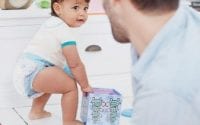 Before giving birth, parents often feel a strong natural urge to provide a safe environment for their baby – often called “nesting.” Of course, your baby won’t be mobile for several months, so don’t feel too pressured to get all the baby proofing done right away. But once baby begins to kick, roll and eventually crawl, you must take the proper precautions to ensure their safety. Baby proofing an entire home can sometimes seem a bit daunting, especially if you are a new parent, so here are some tips to make sure your home is prepared for your baby on the move:
Before giving birth, parents often feel a strong natural urge to provide a safe environment for their baby – often called “nesting.” Of course, your baby won’t be mobile for several months, so don’t feel too pressured to get all the baby proofing done right away. But once baby begins to kick, roll and eventually crawl, you must take the proper precautions to ensure their safety. Baby proofing an entire home can sometimes seem a bit daunting, especially if you are a new parent, so here are some tips to make sure your home is prepared for your baby on the move:
Tip #1: Start early
On average, babies start to crawl at eight month, but many get moving earlier, so it’s never too soon to begin baby proofing. Take advantage of any time you have before baby comes or while your little one is still pretty stationary so you aren’t caught unprepared by an early-mover surprise.
Tip #2: Crawl around
When baby proofing, it helps to think like a baby and see things from baby’s perspective. So I recommend you get down on all fours and crawl around the house yourself looking for potential hazards or anything your baby might want to make her next favorite play thing, such as power outlets.
Tip #3: Protect against future messes
A comfortable, well-fitting diaper is important for a baby on the move as it will not restrict their movement as they explore the world around them. With my patients I recommend Huggies Little Movers Diapers as they will stay snug on baby even while they move around, and in my experience do a great job of containing any messes. With a baby who wants to investigate anything and everything they see, a good diaper will let you enjoy this exciting time without worrying about any extra messes.
Tip #4: Vacuum frequently
Tiny objects on the floor are just waiting to make their way into an exploring baby’s mouth. Try to vacuum your home, especially the baby’s play area two or even three times a week.
Tip #5: Keep track of loose change
Coins are one of the most commonly swallowed object for babies on the move. Keep a careful eye out for these items on the floor or within babies reach as they are a major choking hazard.
Tip #6: Use a room-by-room checklist
Create a personalized checklist of all the items that need to be baby-proofed based on your home to make sure you don’t miss anything. This one here is a good place to start. This will help you create a baby-friendly environment that is also safe for toddlers.
As baby begins to show signs of crawling and his or her interest in new objects begins to peak, baby proofing becomes increasingly important. Use these tips so you don’t have to worry about their safety as they explore.
Note: This article is sponsored by Huggies®. Dr. William Sears is a proud member of the Huggies Parent Council. Huggies® believes deeply in the Power of Hugs. The simple, loving act is proven to support babies’ emotional and physiological well-being. Huggies® diapers and wipes are inspired by a parent’s hug, to nurture baby with care, cradle baby in comfort, and surround baby in protection. Huggies® Little Movers Diapers have a Moving Baby System™, so baby can explore more with a comfy fit that lasts. Learn more at Huggies.com #HuggiesCouncil

